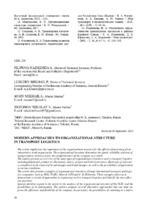| dc.description.abstract | The article emphasizes the importance of the organizational structure for the effective functioning of any industrial or trade organization. The organizational structure determines the speed, reliability and cost of transportation, and as a result, the competitiveness of the company as a whole. The authors present an overview of the main types of organizational structures used in transport logistics, including functional, product (or divisional), matrix, project and hybrid structures. Each type of structure is considered in the context of its advantages and disadvantages, as well as the possibilities of application in various conditions. The article also provides examples of organizational structures of large international transport and logistics companies, such as DHL, FedEx, Maersk, UPS and C. H. Robinson. These examples allow us to demonstrate a variety of approaches to organizing work in transport logistics and identify the most effective practices. Special attention is paid in the article to the analysis of the organizational structure of the SLTC and the possibilities of its optimization. The authors propose several alternative approaches that can help improve the efficiency and flexibility of the company. In particular, the possibilities of switching to a matrix or hybrid structure, using the project structure to process unique projects or tasks, as well as improving internal communication and coordination are being considered. In conclusion, the article emphasizes that the choice of the optimal organizational structure requires a comprehensive analysis and must take into account many factors, including the current business strategy, customer requirements, internal resources and capabilities, as well as trends and opportunities in the field of transport logistics. The authors emphasize that any changes in the organizational structure should be accompanied by adequate changes in the corporate culture and management system, as well as support and training of employees. In general, the article is a valuable source of information for specialists in the field of transport logistics, as well as for managers and business owners who want to improve the efficiency of their operations and increase the competitiveness of their companies. | ru |

